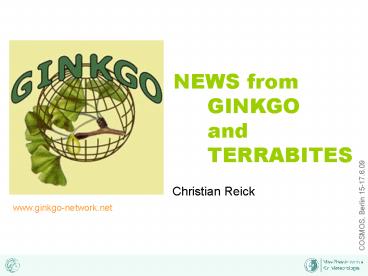The Terrestrial Biosphere in the Earth System - PowerPoint PPT Presentation
1 / 14
Title:
The Terrestrial Biosphere in the Earth System
Description:
for climate and global ecosystem modelling. a discussion forum ... Wetlands: plant functioning and non-CO2 emissions from wetlands, paddy. fields, and agriculture ... – PowerPoint PPT presentation
Number of Views:29
Avg rating:3.0/5.0
Title: The Terrestrial Biosphere in the Earth System
1
NEWS from GINKGO and TERRABITES
Christian Reick
www.ginkgo-network.net
2
What is GINKGO ?
- a network ...
- ... for climate and global ecosystem
modelling - a discussion forum
- for all interested in climate and
vegetation - a platform
- to initiate cooperations
Ginkgo email list ginkgo_at_lists.zmaw.de
currently about 200 people from 20 institutions
www.ginkgo-network.net
3
GINKGO Activities
Sept. 12/13, 2005 1st Workshop on Biosphere
Modelling, MPI-M, HamburgMarch 17, 2006 2nd
Workshop on Biosphere Modelling, PIK,
Potsdam Jan. 11/12, 2007 3rd GINKGO Workshop
MPI-BGC, Jena October 25/26, 2007 GINKGO
Land-Use Workshop, CESR, Kassel November 22/23,
2007 4th GINKGO meeting, MPI-M,
Hamburg January 27/28, 2009 5th GINKGO
meeting, PIK, Potsdam
gt 40 participants
Modelling plant functioning Modelling carbon and
nutrient cycling Modelling plant
ecology Modelling human land use
Topics
4
From GINKGO to TERRABITES
TERRABITES The Terrestrial Biosphere in
the Earth System
- November 22/23, 20074th GINKGO meeting,
MPI-M, Hamburg? Decision for COST-Action - April 2008 preproposal submitted
- May 2008 Invitation for full proposal
- Aug 2008 Submission of full proposal
- Sep 2008 Project approved (1st place out of 5)
- June 12, Kickoff meeting in Brussels
? 14 European countries represented? 84 k/yr
until end of 2013
5
TERRABITES Basic idea
- Climate/Biosphere Projections highly uncertain
due to incomplete process descriptions - More detailed biological/ecological expertise
needed for model improvement - More direct use of Earth Observations necessary
for model validation and calibration
? Bring together expertise from
- Earth System modellers
- Biologists/Ecologist
- Earth observation community
6
TERRABITES OBJECTIVES
The main objective of the Action is a
cross-disciplinary assessment of our current
understanding of the terrestrial biosphere from
an Earth system perspective to improve the
reliability of future Earth system projections in
coupled climate-biosphere simulations.
Secondary objectives
- Mapping of the European research capacities
- Identification of research gaps and synergies
- Provide orientation of European research planning
7
Working Groups
- WG1 Modeling plant functioning (Almut
Arneth, Lund) - WG2 Modeling carbon and nutrient cycling
(Ivan Janssens, Antwerp) - WG3 Modeling plant ecology (Peter van
Bodegom, Amsterdam) - WG4 Modeling human land use (Wolfgang
Lucht, Potsdam)
8
Organization
year
MC-Inauguration Meeting
June 2009
0
Opening Symposium, WGs form, MC Action plan
Phase 1
Feb 2010
1
1
WG 1
WG 4
WG 2
WG 3
2
Feb 2012?
Symposium, Training School, MC Action Plan Phase
2
3
2
Integration of WGs
4
Dec 2013?
Final Symposium, Training School, Book publication
9
Upcoming events
- 6th GINKGO meeting Spring 2010,
MPI-BGC, Jena - TERRABITES Opening Symposion
- Feb. 2010, MPI-M, Hamburg
www.ginkgo-network.net
www.terrabites.net
10
11
Purpose of TERRABITES
- Overcome institutional and disciplinary borders
- Broad interlectual resource mining
- Identification of research overlap and fields of
synergies - Develop common understanding where we are
standing scientifically - Develop interdisciplinary personal relationships
12
Means to achieve the goals
Publications - Synthesis reports from
workshops (EOS, GBP Newsletter) - Topical
reviews in international journals -
Perspective papers - Book publication
Terrestrial Biosphere
Modelingstatus,advances, perspectives
Community interaction - 3 Symposia (100-150
people) - 4-6 topical workshops per year
- Short term scientific missions - WG
meetings
Outreach - Website (project infos, research
landscape) - Brochure - Press information
13
Organization (1)
Management Committee (Chair Vice Chair
country representatives rapporteur) Agenda,
Symposia, Outreach
WG1 (Coordinator 2 Vice Coord.) Workshops(1-2
per yr)
WG2 (Coordinator 2 Vice Coord.) Workshops (1-2
per yr)
WG3 (Coordinator 2 Vice Coord.)Workshops (1-2
per yr)
WG4 (Coordinator 2 Vice Coord.) Workshops (1-2
per yr)
Short Term Scientific Missions
Symposia
MC-Chairs WG Coordinators
Permanent task force
Community involvement Training schools
Including WG and MC meetings
14
Tentative Workshop Topics
- Phase I Harmonization of views between
communities - Global water use and the terrestrial biosphere
- Landscape scale processes and dynamics of soil
organic matter - Long term stabilization of carbon and nutrients
in global ecosystems - Time scale of ecosystem shifts in response to
climate change from present-day observatons
and palaeo-archives - Plant strategies, integration of plant
functional types, plant adaptations upon
climate change and traits - Consolidating long-term spatio-temporal data
sets of land land use - Phase II Exploration of synergies between
communities - Carbon-nitrogen interactions in leaves and
plants, their links to water relations and
litter, heterotrophic activity and soil quality,
and the role of nitrogen- availability as
modulator of the preferred substrate for microbes - Plant-chemistry-climate interactions the
functional interactions of photosynthesis,
stomatal conductance, biogenic emissions of
volatile organic carbon (BVOCs) and ozone
uptake and the damage caused by ozone as
affected by climate and plant productivity. - Disturbances (e.g., fire, herbivory by insects,
mammals, birds) understanding, mapping,
quantification, and implementation into Earth
system models - Wetlands plant functioning and non-CO2
emissions from wetlands, paddy fields, and
agriculture - Validation and verification of global land use
simulations role of national statistics,
maps and metric and the role of earth observation































